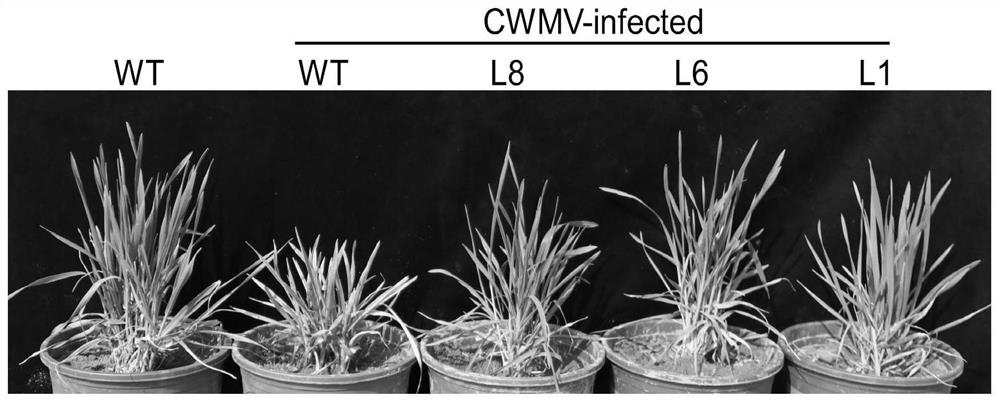A wheat thiosynthase thi1 gene and its application in plant resistance to Chinese wheat mosaic virus
A technology of wheat mosaic virus and synthetase, applied in the field of plant genetic engineering
- Summary
- Abstract
- Description
- Claims
- Application Information
AI Technical Summary
Problems solved by technology
Method used
Image
Examples
Embodiment 1
[0024] Cloning Method of Wheat Thiamine Thiamine Synthase Gene
[0025] First, the total RNA of Yangmai 158 wheat leaves was extracted using the HiPure Plant RNA Mini Kit (Magen), and the extracted total RNA was quantified to 1 μg, and then reverse transcription was performed using the First Strand cDNA Synthesis Kit ReverTra Ace (TOYOBO) The cassette was reverse-transcribed according to the manufacturer's instructions, and the reverse-transcribed wheat cDNA was used to amplify the thiamine thiamin synthase gene.
[0026] The primers were designed as F: ATGGCAGCCATGGCCACCACC (SEQ ID NO: 3); R: GGCGTCCACGATGTCGCCGTT (SEQ ID NO: 4). KOD FX (TOYOBO) high-fidelity enzyme was used to clone the wheat thiamine thiamine synthase gene from the reverse-transcribed cDNA. The reaction conditions were set as follows: 95°C pre-denaturation for 5min, 95°C for 30sec, 56°C for 30sec, 72°C for 90sec, 40 cycles. The reaction system is: 2×Buffer 12.5 μL, 2mM dNTPs 2.5 μL, forward primer F 0.5 μ...
Embodiment 2
[0028] According to the primer sequence in Example 1, a gateway universal adapter (GGGGACAAGTTTGTACAAAAAAGCAGGCTTC (SEQ ID NO: 5) / GGGGACCACTTTGTACAAGAAAGCTGGGTC (SEQ ID NO: 6)) was added to the 5' end of the primer respectively to obtain the primers with the adapter (forward and reverse primers F: GGGGACAAGTTTGTACAAAAAAGCAGGCTTCATGGCAGCCATGGCCACCACC (SEQ ID NO: 7); R: GGGGACCACTTTGTACAAGAAAGCTGGGTCGGCGTCCACGATGTCGCCGTT (SEQ ID NO: 8)), respectively. The gene encoding wheat thiamine thiamine synthetase was amplified by primers with linkers, and the method was the same as in Example 1 to obtain the amplified fragments with linkers. The amplified fragments with adapters were subjected to BP reaction with BP enzyme (Invitrogen Company), and the reaction procedure was as follows: 1 μL of proteinase K was added after treatment at 25° C. for 1 hour, and then treated at 37° C. for 10 minutes. The reaction system is: 2 μL of amplified fragment with adapter, 1 μL of pDONR207 vector, 1 μ...
Embodiment 3
[0030] The pGWB408-THI1 vector containing the thiamine thiamine synthetase gene sequence is transformed into the immature wheat embryo by the method of genetic transformation of wheat mediated by a gene gun, and the steps are as follows:
[0031] 1) Collect immature wheat seeds 13-15 days after pollination (the color of the seeds is whitish with a little green, the embryo is slightly formed with weak protrusions, and the scutellum is about 1 cm), and the immature embryos are inoculated in SD2 medium after being sterilized by 10% NaClO solution. Culture in a dark environment at 24-26°C;
[0032] 2) After 7-8 days of dark culture, select immature embryo calli in good condition, place them centrally in the center of a petri dish containing 0.4M osmotic pressure medium, and place about 38 immature calli within a diameter of 2.5cm. Embryo callus, osmotic pretreatment for 4-6 hours;
[0033] 3) Mix pAHC20 empty plasmid and pGWB408-THI1 recombinant plasmid at a volume ratio of 1:1, ...
PUM
 Login to View More
Login to View More Abstract
Description
Claims
Application Information
 Login to View More
Login to View More - Generate Ideas
- Intellectual Property
- Life Sciences
- Materials
- Tech Scout
- Unparalleled Data Quality
- Higher Quality Content
- 60% Fewer Hallucinations
Browse by: Latest US Patents, China's latest patents, Technical Efficacy Thesaurus, Application Domain, Technology Topic, Popular Technical Reports.
© 2025 PatSnap. All rights reserved.Legal|Privacy policy|Modern Slavery Act Transparency Statement|Sitemap|About US| Contact US: help@patsnap.com


